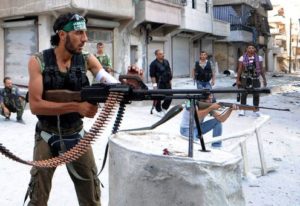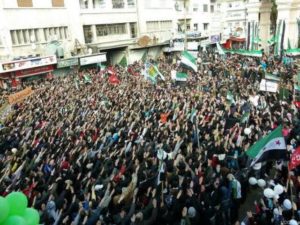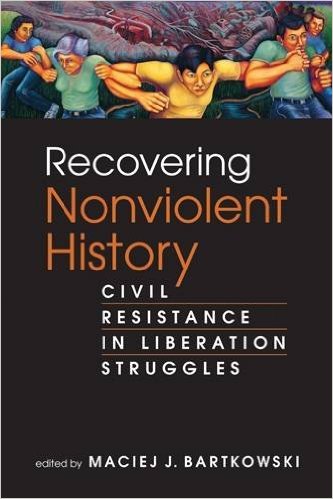According to the advocates of the armed struggle against the Assad regime – both inside and outside Syria – a largely nonviolent resistance that lasted between March and August 2011 had no viable option but to turn violent. I identified at least ten arguments that have been used to justify or account for the shift away from civil resistance in favor of the armed struggle in the country. Some of these arguments explicitly devalue the role, and impact of nonviolent resistance.
1. Brutality argument
• It was naïve to continue nonviolent struggle in the face of an extremely brutal opponent. In fact, nonviolent activists stood no chance against a ruthless regime. In these circumstances their resort to arms was the only rational choice Syrians could make.
2. Ethnic polarization argument
• Ethnic and religious polarizations were too strong in Syria and it was unrealistic to expect Alawites or Christian to defect the regime and join the anti-Assad resistance.
3. Self-defense and honorable death argument
• Syrians had the right to self-defense and armed protection of their communities against violent thugs of the regime. Failure to resort to arms in order to defend oneself would have led to a carnage. Furthermore, soldiers that deserted from the Syrian army feared they would have been killed in reprisals for their ‘treason’ – defections. Armed resistance thus offered a choice to die with a gun in hand rather than to be slaughtered without a fight.
4. Redressing an affront argument
• Regime’s arrests, tortures, rapes and killing were an affront to ordinary Syrians and needed to be revenged. The violent rebellion against the Assad regime is to right an affront and falls within the ‘just’ tradition of honor killing that is part of the history and culture of the society.
5. Historical argument
• The road to a genuine liberation can never be peaceful. Liberation struggles in Libya, Kosovo, or earlier in Algeria or Syria under the French protectorate were violent. Earlier uprisings against Syrian Ba’ath regime were also violent.
6. Foreign fighters’ argument
• Violence on the opposition side would ensue anyway given the influx of the foreign fighters whose primarily means to fight the regime is the armed struggle.
7. Complementarity argument
• Violent struggle more often than not incorporates civil resistance. Nonviolent political organizing is needed for violent resistance to succeed. This was the case with the grassroots insurgencies in Vietnam against the United States or in Afghanistan against the Soviet Union and now against NATO. The combination of violent resistance and nonviolent organizing is also practiced by the political-armed groups such as Hizbullah and Hamas.
8. Violent adversary understands only violence
• Violence works against Assad as he is a rational thug who wants to ensure the survival of his family and his political control. He agreed to give up his chemical weapons when faced with an imminent military attack by a more powerful adversary. Consequently, Syrians need more not less weapons and widespread violent uprising to tip the balance of force in favor of the resistance.
9. Blaming the victim argument
• Criticism of Syrians for their resort to arms against a dictator is immoral. Syrians are victims and Assad is a perpetrator.
10. Passivity of international community
• International community does not intervene on behalf of nonviolent movements in contrast to the well-known interventions in support of violent insurrectionists – e.g. in Libya or earlier in Kosovo. The violent struggle had more chances than its nonviolent counterpart to bring about greater international involvement in the conflict that could eventually topple the Assad regime.
My take on the misconceptions
1. Civil resistance is a realistic alternative to violence though, paradoxically, it faces a higher burden of proof than the violent struggle
The continuance of civil resistance would have been no more unrealistic than the eventual choice of the armed resistance. In fact, the resort to violence by the Syrian opposition was the most unrealistic options among all available alternatives to tip the balance of force in their favor. The terrible outcome of the violent strategy in Syria, clearly seen today, shows that the choice of the armed struggle – rather than that of the nonviolent resistance – was in fact “naïve”, “idealistic” and “irrational.” By turning to arms and prematurely terminating the six-month old nonviolent resistance (between March and August 2011), the Syrian opposition began fighting the regime at its strongest and on the regime’s own violent terms. The likelihood of success in the armed challenge dramatically decreased for the poorly armed opposition. In this unequal conflict the rebels had to turn to the external parties for the military assistance. Such help never comes free and gives external actors excessive influence over the domestic situation. The choice of armed struggle, although emotionally satisfying, was less than well-thought-out strategy to reach a successful outcome in the conflict.
Worse, the choice of arms has faced much lower level of scrutiny as a viable strategy than the civil resistance did. Never in the history of civil resistance struggle were nonviolent actionists exempted from the some kind of violent repression. In fact, wherever civil resistance occurs violence by its adversary is and should be expected. Far too often the efficacy of nonviolent resistance is dismissed in the face of activists’ killings while the deaths of rebels in violent insurgency is seen as a usual progression of the conflict. Rather than the sign of weakness of the civil resistance strategy repression exposes government’s limitations on its control over the population. Now, the regime is compelled to rely on the extraordinary (and no more voluntary) methods to ensure obedience. When a disproportionate violent reaction backfires – as it happened in Syria in the first months of nonviolent resistance – it increases domestic and international sympathy for the activists and creates fissures among government’s supporters and between regime’s moderates and hardliners. This reveals more about the authorities’ vulnerabilities than that of the citizens. In spite of the evidences to the contrary the repression against peaceful resisters in Syria was used to claim that nonviolent resistance failed and armed response was justified. At the same time, when the armed rebellion faced even more ferocious violence by the Assad regime (e.g. the fighter jets and chemical weapons that had not been used during the civil resistance were deployed by the regime once the resistance turned violent) this was hardly seen by anyone as the evidence that the armed rebellion stopped being effective. Furthermore, recent scholarly work Why Civil Resistance Works by Chenoweth and Stephan showed that a brutal nature of the regime does not impact the overall likelihood of success of nonviolent resistance.
2. Ethnic polarization is not an obstacle for civil resistance
The 2007 Freedom House study on the adversarial conditions and civil resistance concluded, among others, that between 1973-2005 a degree of societal or ethnic polarization determined neither the emergence of civil resistance, nor its eventual success and failure. Correspondingly, the ethnic polarization in Syria has not prevented the civil resistance movement from emerging in March 2011. In fact, at its onset, different ethnic groups led nonviolent actions against the Assad regime. There were examples of anti-regime protests and demonstrations organized not only by Sunnis but also Christians, Kurds and Alawites. All sectors of the society felt one way or the other that they are oppressed or subjugated by the Assad family. Increasing unity among various groups not a growing ethnic polarization was the main concern for the regime during the civil resistance phase. And this is why, from the very beginning of the civic uprising, the government spent considerable resources to depict the resistance as driven by the Sunni extremists. Turning peaceful revolution supported overly or tacitly by the majority of Syrians into a violent resistance was the most strategically beneficial outcome for the regime. It was also the worst result for civil resistance as the coalition building across various societal groups and greater mobilization of people had propelled the movement. These drivers became significantly weakened once the resistance turned violent. It was the armed rebellion and not civil resistance that reinforced the regime’s strategy of divide and rule while, at the same time, raising ethnic divisions and deepening polarization. This, in turn, impaired the chances for building a nationwide movement against the Assad family.
3. Arms do not offer protection. Honorable death is strategically pointless
There are no studies that would compare the survival rate or battle deaths in both violent and nonviolent conflicts although future NAVCO 3.0 dataset will, among others, offer that statistics. The anecdotal evidences and individual case studies strongly suggest, however, that no major atrocities that will be equivalent to ethnic cleansing or genocide happened during civil resistance struggles in contract to civil wars. Additionally, the study that looked at violence against civilians in wars between 1989-2004 suggested that the civilian risk of dying in conflict countries with nonviolent movements was less than 1% in comparison with countries that experienced civil war. As for Syria specifically, the probability of dying in the conflict jumped by more than three times as soon as the opposition abandoned nonviolent resistance in favor of the armed rebellion.
No violent resistance that is militarily weaker than its adversary is ever able to protect civilians. Thinking otherwise goes against a common sense and a sound resistance strategy. A weaker side might eventually be able to win the war after it gains a military advantage – often as a result of the external assistance – but that usually comes with huge civilian losses. Two years into the armed resistance Syrian rebels have been able to achieve neither of the objectives: to protect locals and win the war. Arguably, given a historically lower degree of casualties and an impressive historical record of undermining brutal regimes civil resistance in Syria would have been an effective strategy in a long run, both to defend people and defeat the regime.
Finally, the Syrian army defectors should have had little strategic grounds to believe that, as lightly armed as they were, they would have increased their chances of survival when engaged in the firefight with much more powerful adversary. If they looked for an honorable death while resisting Assad violently their fight missed entirely the strategic objective that drove him to take arms in the first place – to survive and protect their own lives and those of the civilian population.
4. Revenge is not part of the effective strategy to wage a successful resistance
Similarly to a sound military campaign civil resistance is based on a rational calculus of costs, risks and benefits of different strategic options and tactics. In fact, a major aspect of civil resistance success is driven by how effective the resistance is in keeping a tab on emotions in favor of a rational analysis. The instinct of honor killing or a revenge is often ingrained in communal traditions that, on one hand, undergird future rebellions but also contain the seeds of their own demise. They often fail to create sustainable movements based on a diverse social or ethnic composition because such endeavor would require rejection of honor killing or right to revenge in favor of reconciliation and reaching out. Syrians were not predestined to engage in an eye for an eye struggle to the detriment of a more strategic approach in the same way traditionally militant Pashtuns led by Abdul Ghaffar Khan in the 1930s were not doomed to violence. In fact, the latter managed to create a 100,000-strong nonviolent army as did Kosovars that built their nonviolent movement in the 1990s. Both civil struggles successfully overcame emotional or traditional drive to ‘just’ violence rooted in generational-long animosities and intercommunal conflicts in favor of cross-familial or intertribal cooperation, mutual aid, nonviolent mobilization and civil resistance against a common adversary.
5. History lends support to civil resistance not armed rebellion
Poor historical inferences about conflicts in general and nonviolent struggles in particular contributed to the overconfidence in the effectiveness of arms and underassessment of what nonviolent conflict can achieve to win people’s freedoms. There is also almost nonexistent calculus of historical costs for nonviolent and violent struggles. Syrians failed to engage in more thorough discussions regarding costs and effectiveness of the Islamists’ armed uprising against the Baathist regime from the mid 1970s till the beginning of the 1980s and reflect more deeply on a relatively successful and united nonviolent struggle in Syria against the French colonial authorities in the middle of the 1930s. Furthermore, the Syrian rebel army and their western supporters missed another important piece of data that winning liberation through violence as it happened in Algeria at the beginning of the 1960s and recently in Libya on average decreased significantly the chances for these countries to become democracies- by at least 85% – in contrast to more than 80% of the likelihood that a successful nonviolent resistance would lead to a democratic outcome within 5 years after the end of the conflict. See Why Civil Resistance Works.
6. Syrians not the foreign fighters determined the nature and direction of the struggle
The foreign fighters engaged in violent battles with the Assad loyalists from the beginning of 2012 when the resistance had already turned into the armed uprising. In other words, foreign fighters joined violent rebellion rather than started it. Syrians themselves and not the foreign contingents determined the strategy used to challenge Assad. It is true that with the influx of foreign fighters the choice of violence has only been reinforced. If civil resistance, however, dominated the conflict landscape in spring 2012 that would have meant that the nonviolent discipline had now been strongly ingrained in the culture of the Syrian resistance. Consequently, the foreign fighters would have had an extremely limited space to operate within, and faced costly social ostracism by the indigenous population. With the difficulties of finding local support and shelter, and challenges with securing provisions foreign fighters might have faced marginalization and have become a relatively easy target for the regime.
7. Dictator fears the force that can dislodge his control
A superior military is one of the forces that the dictator fears it can dislodge his control. It is one of the reasons why Assad yielded on chemical weapons when faced with the threat of the American attack. But the opposition does not have such a superior military force at its command and is unlikely to acquire it in the future even with the external assistance. Meanwhile, the Assad forces keep being replenished with the military aid from Russia, Iran and Hezbollah. Consequently, violent resistance against materially stronger dictator is not an effective force to dislodge his control.
If dictators understand violence so well why to use such well-understood weapon against them? – one of my colleagues, Jack DuVall, observes. Eventually, the struggle is won not because an adversary understands the instrument used by its opponent but precisely the opposite – when he fails to phantom the strategy deployed against him. Civil resistance is the phenomenon that brutal dictators have more difficulties in grasping and thus dealing with.
8. Civil resistance is undermined by violent resistance
Although violent struggle can feed on and be reinforced through nonviolent political organizing, as it was the case with the national communist struggle in China in the 1940s or the North Vietnamese insurrection against the South Vietnamese and US forces in the 1960s, civil resistance is mortally weakened if it colludes with violence. The possibility of violent repression backfiring decreases in the mixed resistance as the dictator and its supports effectively brand the whole resistance as being violent. This, in turn, justifies in the eyes of the public the extraordinary violent measures deployed by the government against the rebels.
Once violent resistance emerges it quickly overshadows civil resistance as a dominant means of struggle – as it happened in Syria and in other conflicts – e.g. in Kosovo in the late 1990s, Libya in 2011, or in Sri Lanka in the 1950s. Consequently, civil resistance loses its two important leverages in the fight against the opponent: its participation and defection drivers. On average, between 1900-2006, armed struggles were 4 times smaller in terms of citizens’ participation in the violent campaigns than in nonviolent resistance (Chenoweth and Stephan). A decreased participation as a consequence of the emerging violent flank bodes ill for the civil resistance. Furthermore, violence used by some extremists within or on the fringes of the movement consolidates the opponents as much as it polarizes movement’s supporters. Movement’s adversary can rally its supporters easier around the call to resist violent opposition and stay united which decreases the chances for the defections from the regime. It is always difficult to shift one’s loyalties towards another group that is perceived as posing a physical threat.
Moreover, violence perpetrated by a movement that contradicts its goal of building peaceful and democratic society helps the regime to further dehumanize it. Violence on the part of the opposition- even if limited – helps the regime to show to its own supporters as well as outsiders that the government faces predators, murders and rapists and itself is a victim of violence. It thus creates greater psychological and social distance between the rebels and their potential domestic and international supporters, further undermining chances for civil resistance to bring about mass defections from the regime and a greater international solidarity.
9. Syrians are victims of their own poor resistance strategy
Assad is the murderous perpetrator. Opposition and a general population are his victims. However, Syrians are also victims of their own poor strategic choices made to fight that oppression. It is actually immoral – not when the resisters are criticized – but that under the cover of the victim argument – the strategic shortsightedness of the opposition and rebels are denied. Around the beginning of 2011, the Syrian population understood that they were the key to their own liberation and their silence, compliance and obedience helped sustain the Assad regime. They realized they were part – voluntarily or not – of the evil system. The rebellion of ordinary Syrians came from the realization that they were themselves the problem as well as held the key to their own liberation from the enslavement. However, this psychological awakening did not match smart strategies needed to turn emotional readiness to stand up for ones’ rights into a rational strategy that would increase the probability of eventual victory. For example, Bassam Ishak, a Syrian political dissident, identified at least two failed strategies of the Syrian civil resistance when it began – the failure to mobilize all Sunnis to join nonviolent struggle and to understand better the culture of violence in the Syrian society in order to devise more effective strategies for maintaining nonviolent discipline. Moreover, the impatience of the opposition mixed with the belief that Syrians can achieve their liberation as quickly as Tunisians and Egyptians did led to the failure to develop a collective mentality for a protracted struggle and contributed to the premature abandonment of the nonviolent resistance. Consequently, Syrians became double victims – of the regime but also of their own wrong choices, particularly the ones that led them to opt for violent resistance.
10. Passivity of the international community
One of the arguments of the opponents of civil resistance was that the international community has not developed an effective mechanism to support nonviolent movements. However, this should in no way justify the resort to violence. It is true that the existing doctrine of the Responsibility to Protect (R2P) has set up the mechanism to intervene when violence breaks out on all sides of the conflict as it happened in Bosnia, Kosovo or Libya. And there is no mechanisms – besides the traditional instruments of punishing the regimes through sanctions – that could be used by the international community to provide a robust assistance to the nonviolent resistance movements when they last and help prevent them from turning into armed resistance. Therefore, my colleague, Peter Ackerman, rightly so, advocates the Right to Assist (R2A) as the new international principle designed to help nonviolent movements. Such a new norm could lower down a political threshold that is needed to support the practice of providing assistance to peaceful resisters as this type of intervention would be neither violent (as is often the case with R2P) nor selective (would be applied wherever widespread civil resistance emerges) and thus would hardly need the approval of the too-often-divided UN Security Council.
Tags: armed resistance, Assad, civil resistance, misconceptions, nonviolent resistance, Syria
 If the deal is confirmed Yanukovych won from Putin much more than the threats that he likely heard during the secret meeting with the Russian President on Nov. 9 that soon afterwards led Yanukovych to make an abrupt U-turn in the negotiations with the EU. Paradoxically, ongoing demonstrations might have inadvertently helped Yanukovych to get a better deal from Putin than otherwise. In fact, Yanukovych might have been interested in rising the tensions in the country to win more concessions from Putin and, by default, become Putin’s indispensable man that will keep Ukraine in Russia’s orbit. The crackdown on the protesters ordered by Yanukovych regime in the early morning of Nov. 30 might have been actually designed to raise these tensions. The demonstrators were in fact preparing to wind down their protest after the EU Vilnius summit and thus there was little rationale for the regime to use a brutal force. However, if what was needed was the crisis that would provide Yanukovych with more leverage over Putin (which he fears) then the last week crackdown was a rationally-driven, calculated sinister plot on the part of the regime and its president.
If the deal is confirmed Yanukovych won from Putin much more than the threats that he likely heard during the secret meeting with the Russian President on Nov. 9 that soon afterwards led Yanukovych to make an abrupt U-turn in the negotiations with the EU. Paradoxically, ongoing demonstrations might have inadvertently helped Yanukovych to get a better deal from Putin than otherwise. In fact, Yanukovych might have been interested in rising the tensions in the country to win more concessions from Putin and, by default, become Putin’s indispensable man that will keep Ukraine in Russia’s orbit. The crackdown on the protesters ordered by Yanukovych regime in the early morning of Nov. 30 might have been actually designed to raise these tensions. The demonstrators were in fact preparing to wind down their protest after the EU Vilnius summit and thus there was little rationale for the regime to use a brutal force. However, if what was needed was the crisis that would provide Yanukovych with more leverage over Putin (which he fears) then the last week crackdown was a rationally-driven, calculated sinister plot on the part of the regime and its president.






Recent Comments